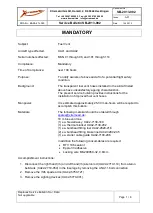
GLOSSARY
FREQUENTLY USED KITEBOARDING & WIND TERMINOLOGY
9
10
11
LAUNCHING - the motion in which the pilot steers the kite from their
partner's hands into the sky.
SELF LAUNCHING - a technique in which the pilot launches the kite
without assistance, usually by weighting down a wing tip with sand
until he/she is ready to launch.
RE-LAUNCHING - the motion in which the pilot steers the kite off of the
water and back into the sky.
BODY DRAGGING - this is an instructional tactic / step in which the pilot
flies the kite while in the water, but without the board. The pilot will
launch, then walk to the water, and basically drag in the water while
practicing flying, re-launching and self-rescue techniques.
WATER STARTING - the motion of the pilot in which he/she goes from
sitting or lying in the water to standing on the board.
GYBING - the motion in which the pilot changes the direction of the
board he/she is riding. The pilot switches from a starboard tack to a port
tack or vice versa.
PLANING - the point in time in which the pilot gets the board skimming
on the water.
LANDING - the motion in which the pilot steers the kite into their
partner's hands on shore.
OVER-POWERED - a situation in which the pilot has a kite too powerful
for his/her ability level, weight, strength, and/or wind conditions.
UNDER-POWERED - a situation in which the pilot has a kite not powerful
enough for his/her weight, strength, and/or wind conditions.
REACH - a direction of travel relative to the wind direction. Generally 90-
160 degrees off the wind.
LULL - a term used to describe wind when it lessens in strength, for any
amount of time. A term also used to describe the complete de-powering
of a kite.
LUFF - a term used to describe what happens to the kite in a lull.
SIDESHORE - wind is blowing from the left or from the right, parallel to
the shore. Ideal wind direction for kiteboarding.
ONSHORE - wind is blowing directly or to a great extent directly from the
water toward the land. Utilize caution when operating your kite in or
near water in this wind direction.
SIDE ONSHORE - wind is blowing from either the left or the right and
from the water toward the land. This is a combination of onshore and
sideshore wind. Utilize caution when operating your kite in or near water
in this wind direction.
OFFSHORE - wind is blowing from the shore directly or to a great extent
out to the water. Do not operate your kite in or near water in this wind
direction.
SIDE OFFSHORE - wind is blowing from either the left or the right and
from the shore out to the water. This is a combination of offshore and
sideshore wind. Do not operate your kite in or near water in this wind
direction.
GUSTY WIND - wind is inconsistent and varies considerably from one
wind strength to another.
DOWNWIND - the direction in which the wind is traveling.
UPWIND - the direction from which the wind is blowing.
LEEWARD - the downwind side of the kiteboarder.
WINDWARD - the upwind side of the kiteboarder.
KNOTS - a measure of speed based on nautical miles.
1 knot = 1 nautical mile per hour.
1 knot = 1.15 miles per hour.
1 knot = 1.85 kilometers per hour.
MPH - Miles Per Hour. A measure of speed.
1 mph = 1.6 kilometers per hour.
BEAUFORT SCALE - a system for estimating wind strength based on the
effects wind has on the physical environment (eg. the behavior of
waves, smoke, etc.). Instruments are not used to determine wind
strengths in this point scale (O = calm to 12 = hurricane).
Содержание CO2 2005
Страница 1: ...2005 KITE MANUAL CONTRA NITRO CO2 ELEMENT...

































